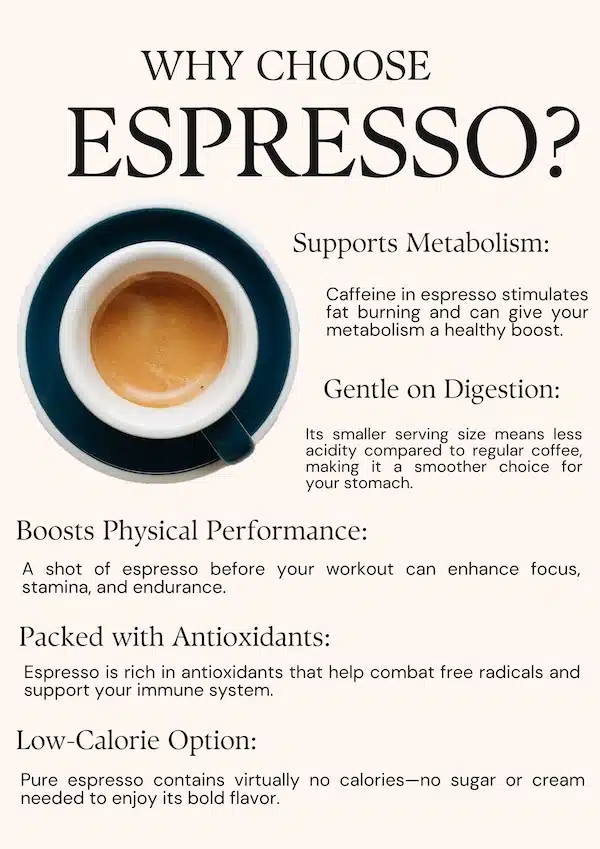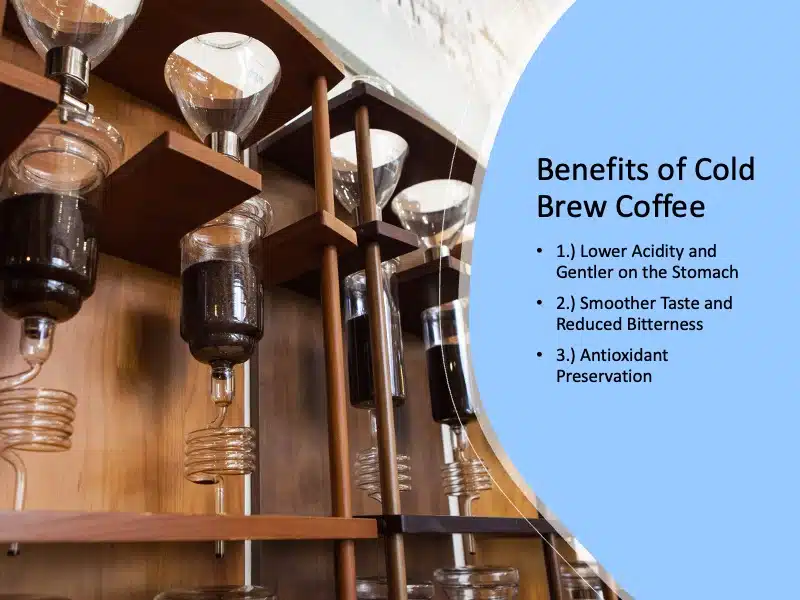Coffee: Health Benefits, Best Types, Brewing Tips & More!
Coffee is more than just a daily pick-me-up; it’s a global phenomenon.
With over 400 million cups consumed daily in the U.S. alone and more than 500 billion cups annually worldwide, coffee is a deeply rooted part of human culture (Statista, 2024).
Coffee delivers unique health benefits, ranging from improved cognitive function to long-term disease prevention.
However, the way it’s grown, brewed, and consumed all affect its impact on your body and the planet.
Whether you’re a die-hard espresso drinker or just beginning your journey into better brews, this guide will explore how coffee can improve your health, your lifestyle, and even your values.
What Is Coffee?
Coffee is a brewed beverage made from the roasted seeds of the Coffea plant. These seeds, commonly referred to as coffee beans, are typically sourced from tropical regions around the world, including countries in South America, Africa, and Southeast Asia.
There are two main species used in coffee production: Coffea arabica and Coffea canephora (commonly known as Robusta).
Arabica beans are generally sweeter and more aromatic, while Robusta beans offer a stronger, more bitter flavor and higher caffeine content.
The beans undergo a process of harvesting, drying, roasting, and grinding before being brewed into the drink we know as coffee.
While preparation methods vary widely, ranging from espresso and drip brewing to French press and cold brew, each method produces unique flavor profiles and caffeine levels.
Coffee is cherished not only for its rich taste and stimulating effects but also for its deep cultural significance and emerging reputation as a health-promoting beverage.
Different Types of Coffee Drinks
The world of coffee is incredibly diverse. From brewing techniques to added ingredients, each coffee drink offers a unique combination of flavor, caffeine content, and potential health impact.
Understanding the different types of coffee drinks can help you choose the best option for your goals and preferences.
| Coffee Drink | Caffeine Content (mg per serving) | Calories (Approx.) | Main Ingredients |
|---|---|---|---|
| Americano | 63-150 | 2-5 | Espresso, hot water |
| Cappuccino | 63-75 | 80-120 | Espresso, steamed milk, foam |
| Latte | 63-75 | 120-200 | Espresso, steamed milk |
| Macchiato | 63-75 | 10-30 | Espresso, milk/foam |
| Mocha | 85-175 | 200-350 | Espresso, milk, chocolate syrup |
Drip Coffee
Drip coffee, also known as filter coffee, is brewed by pouring hot water over ground coffee in a filter.
It has a more diluted caffeine concentration than espresso but is typically consumed in larger volumes.
Unfiltered drip coffee may contain diterpenes like kahweol and cafestol, which can modestly raise LDL cholesterol levels if consumed in excess (Urgert & Katan, 1997).
Paper filters help remove these compounds, making filtered drip coffee a healthier daily option.
Espresso

Espresso is a concentrated coffee brewed by forcing hot water through finely ground coffee under high pressure.
It contains a high level of caffeine per ounce and is often the base for drinks like lattes, cappuccinos, and macchiatos.
Due to its pressure-based extraction method, espresso is rich in antioxidants such as chlorogenic acid.
However, despite the health benefits of espresso, its potency makes it less suitable for individuals sensitive to caffeine.
Cold Brew Coffee

Cold brew coffee is made by steeping coarse coffee grounds in cold water for 12–24 hours.
It produces a smoother, less acidic coffee that’s easier on the stomach, making it a popular choice for people with acid sensitivity.
Despite its mellow taste, cold brew can be higher in caffeine depending on the ratio of coffee to water and steeping duration.
It also retains many of the same antioxidants as hot-brewed coffee, contributing to its potential health benefits.
Cold Drip Coffee

Cold drip coffee, also known as Dutch or Kyoto-style coffee, is a sophisticated brewing method that slowly extracts coffee over several hours using cold water.
Unlike cold brew, which involves steeping grounds in water for extended periods, cold drip relies on gravity to pass cold water drop by drop through a bed of coffee grounds and into a collection vessel below.
This meticulous process typically takes 6–12 hours and produces a highly concentrated coffee that is smooth, aromatic, and low in acidity.
The resulting brew is often described as having more refined flavor notes compared to immersion-based cold brew, with brighter tones and a lighter body.
Cold drip coffee retains the full spectrum of coffee’s beneficial antioxidants and tends to have a slightly lower caffeine concentration than cold brew, although this depends on the coffee-to-water ratio and brew time.
It’s gentler on the stomach, making it an excellent option for individuals with acid reflux or digestive sensitivity.
Because of its intricate setup, cold drip coffee is often found in specialty cafes or prepared using unique, visually striking equipment.
However, home versions are available for enthusiasts who enjoy both the flavor and the craft of slow brewing.
Bulletproof Coffee

Bulletproof Coffee is a high-fat drink made by blending coffee with MCT oil and grass-fed butter.
It was popularized for its use in ketogenic and low-carb diets due to its ability to provide prolonged energy and mental focus without a blood sugar crash.
While some people use it as a meal replacement, Bulletproof Coffee is high in calories and saturated fats.
It’s best consumed strategically, such as before workouts or during intermittent fasting windows, and not as a standard daily drink.
Americano
An Americano is made by diluting espresso with hot water.
This results in a beverage similar in strength to drip coffee but with a different flavor profile, which is richer and slightly more acidic due to the espresso base.
Americanos are a great choice for those who enjoy espresso flavor but want a lower caffeine concentration per sip.
Cappuccino
A cappuccino is a balanced combination of one part espresso, one part steamed milk, and one part milk foam.
It offers a creamy texture with the robust flavor of espresso, making it a favorite morning beverage.
While tasty, cappuccinos contain more calories than black coffee due to the added milk.
Latte
A latte is similar to a cappuccino but uses more steamed milk and less foam. This results in a smoother, milder flavor that many people enjoy with added flavor syrups.
Lattes are highly customizable but often include added sugar, so be mindful if you’re watching caloric intake or trying to reduce added sweeteners.
Macchiato
A macchiato is essentially an espresso “stained” with a small amount of milk or milk foam. It maintains the bold flavor of espresso while adding just a touch of creaminess.
This is a low-calorie option compared to milk-heavy drinks like lattes.
Mocha
A mocha blends espresso, steamed milk, and chocolate syrup, often topped with whipped cream. While indulgent and dessert-like, it’s much higher in sugar and calories than most coffee drinks.
It’s best treated as an occasional treat rather than a daily drink.
Reasons You Should Drink Organic & Fair Trade Coffee as Much as Possible
Each cup of coffee has a ripple effect, from the people who grow it to the environment it impacts.
Choosing organic, fair trade beans sends a clear message: sustainability, health, and human dignity matter.
You’re not just fueling your day—you’re supporting communities and ecosystems worldwide.
What Makes Coffee Organic and Fair Trade?
- Organic: Grown without synthetic pesticides, herbicides, or GMOs. Richer soil and biodiversity improve flavor and antioxidant content.
- Fair Trade: Ensures farmers receive fair wages, ethical working conditions, and community investment (Raynolds, 2009).
Health Benefits of Organic Coffee
Organic coffee often contains higher antioxidant levels and fewer pesticide residues (Gorecki & Hallmann, 2020).
This reduces the risk of endocrine disruption and long-term chronic illness (Gore et al., 2015).
It’s a cleaner, safer option for anyone concerned about environmental toxins or the ethics of their food choices.
Organic practices avoid synthetic chemicals, preserving soil and water health. Shade-grown coffee also supports biodiversity and wildlife conservation.
Ethical & Economic Benefits of Fair-Trade Coffee
Fair Trade supports small-scale farmers by offering stable pricing and funding for local infrastructure.
It also ensures children are not exploited in coffee farming operations (Arnould et al., 2009).
Health Benefits of Coffee

Coffee is one of the most researched beverages in the world, and for good reason. Beyond its energizing effects, coffee is packed with bioactive compounds that offer a range of health-promoting benefits.
From your brain to your heart and even your metabolism, regular coffee consumption has been linked with improved physical and mental well-being.
While it’s long been celebrated for its ability to sharpen focus and boost alertness, modern research continues to uncover additional health benefits of coffee.
When consumed in moderation, coffee can be a powerful part of a healthy lifestyle, offering much more than just a morning routine.
Improves Cognitive Function
Caffeine, the central stimulant in coffee, blocks adenosine receptors in the brain. This leads to increased alertness, improved memory, and faster reaction times (Fredholm et al., 1999).
It’s why coffee is often called “liquid focus.”
Beyond caffeine, coffee also contains compounds like theobromine and theophylline—mild stimulants that can subtly elevate mood and mental performance (Haskell et al., 2005).
Research shows regular coffee drinkers perform better on tasks involving attention and memory (Smith et al., 2012).
For anyone navigating demanding mental tasks, coffee can be a powerful ally.
Reduces Risk of Type 2 Diabetes
Drinking coffee is strongly associated with a lower risk of developing Type 2 diabetes.
A large-scale meta-analysis found that each additional cup of coffee per day reduced diabetes risk by about 7% (van Dam & Hu, 2005).
Chlorogenic acid, a major antioxidant in coffee, helps regulate blood sugar by inhibiting glucose absorption in the intestine (Battram et al., 2006).
Both caffeinated and decaf coffee show these effects, although the benefits may differ slightly.
Improved insulin sensitivity and increased adiponectin levels, hormones linked with better glucose control, are also found in habitual coffee drinkers (Salazar-Martinez et al., 2004).
Supports Heart Health
Despite its temporary impact on blood pressure, moderate coffee intake is linked with reduced risks of coronary heart disease and stroke (Larsson & Orsini, 2011).
The polyphenols in coffee, especially chlorogenic acid, improve blood vessel function by enhancing nitric oxide bioavailability.
This supports endothelial health and reduces arterial stiffness (Ochiai et al., 2014).
Consuming 3 to 5 cups of coffee per day appears to offer the best balance of cardiovascular protection without adverse effects (Malongane et al., 2017).
Powerful Antioxidant Properties
For many people, coffee is the largest dietary source of antioxidants.
It contains chlorogenic acid, hydrocinnamic acids, and other compounds that fight oxidative stress and inflammation (Chu et al., 2009).
These antioxidants are key in reducing the risk of chronic diseases like cancer, neurodegenerative disorders, and cardiovascular disease (Sies et al., 2017).
They also promote liver health and bolster immune defense (Bravi et al., 2013).
Importantly, these antioxidants exist in both regular and decaffeinated coffee, offering flexibility for caffeine-sensitive individuals.
Supports Weight Loss
Coffee is good for weight loss for several reasons, and you don’t even need to try something strange like the coffee loophole diet for weight loss.
Caffeine, itself, boosts metabolic rate by 3–11%, increases fat oxidation, and mobilizes stored fatty acids for energy.
These mechanisms can increase fat loss and improve athletic performance (Heckman et al., 2010).
Chlorogenic acid also helps regulate blood sugar and reduce fat accumulation. Combined with appetite suppression, black coffee can be an effective tool in a weight loss diet plan.
However, if you are serious about using coffee to help lose weight, you should stick with plain black coffee or consider healthy sugar alternatives for coffee.
Unlike sugar, certain ingredients can amplify coffee’s fat-burning potential, making it an even more powerful tool for weight loss.
Ingredients you can add to your coffee for weight loss include:
- Cinnamon: This spice helps regulate blood sugar levels and improve insulin sensitivity, reducing the risk of fat storage after meals.
- How much cinnamon you should add in coffee for weight loss? Start with ¼ to ½ teaspoon per cup—just enough to provide metabolic benefits without overwhelming the flavor.
- Turmeric: Known for its anti-inflammatory and antioxidant properties, turmeric can support gut health and reduce systemic inflammation, which is often linked to obesity and metabolic resistance.
- A pinch of salt: When added in small amounts, salt can help replenish sodium lost during workouts and support proper hydration, especially when following a lower-carb or fasting-based weight loss plan. It may also increase electrolyte balance during morning exercise.
If you’re specifically interested in the best coffee for weight loss, I believe Four Sigmatic Happy Gut Coffee is the best option due to its properties that support digestion and fat metabolism.
Last update on 2025-04-19 / This article includes affiliate links/Images via Amazon Product Advertising API. I may earn commissions on purchases made through these links.
How Much Coffee Should You Drink?
While coffee offers a wide range of health benefits, drinking the right amount is key to maximizing its positive effects without experiencing unwanted side effects.
Factors like caffeine sensitivity, time of day, and individual health conditions all influence how much coffee is appropriate for each person.
Understanding your ideal intake can help you enjoy coffee’s energizing and antioxidant-rich properties while avoiding issues like sleep disruption, jitteriness, or elevated heart rate.
General Recommendations
According to the FDA, up to 400mg of caffeine per day, roughly 3 to 4 cups of coffee, is considered safe for most adults.
Exceeding this can increase the risk of anxiety, sleep disruption, and heart palpitations.
Timing Matters
Avoid drinking coffee too late in the day, as it can interfere with sleep.
Caffeine has a half-life of about 5–6 hours, so even an afternoon cup may linger into the evening (Drake et al., 2013).
Individual Differences
People with anxiety, hypertension, or certain GI issues may need to limit coffee or choose low-acid, decaf, or mushroom-based blends like those from Four Sigmatic or Puroast.
Options like Puroast Low Acid Coffee and Four Sigmatic Happy Gut Coffee are the best types of coffee for sensitive stomachs, as they offer smoother acidity profiles and functional ingredients that support digestive health without the discomfort often associated with regular brews.
Last update on 2025-04-19 / This article includes affiliate links/Images via Amazon Product Advertising API. I may earn commissions on purchases made through these links.
Why You Should Choose Black Coffee Most Often
Black coffee offers the full range of coffee’s natural health benefits without the added calories, sugars, or fats that often come with milk-based or sweetened coffee drinks.
When you drink it plain, you’re consuming a low-calorie beverage rich in antioxidants, polyphenols, and bioactive compounds that support metabolic health, brain function, and cardiovascular wellness.
Adding milk, cream, flavored syrups, or sugar can quickly turn coffee into a high-calorie, high-sugar beverage, especially when consumed multiple times per day.
These additions may increase your risk of blood sugar spikes, weight gain, or even elevated cholesterol levels over time, particularly if you’re relying on heavily processed creamers or sweeteners.
Black coffee also provides a more stable energy boost without the blood sugar fluctuations that sweetened drinks can cause.
By keeping your coffee simple, you retain all the core benefits, such as mental clarity, fat oxidation, and improved physical performance, while minimizing the nutritional downsides.
If you’re trying to reduce inflammation, improve insulin sensitivity, or support weight loss, drinking black coffee regularly is one of the simplest and most effective choices you can make.
Final Thoughts: Is Coffee Good for You?
Yes, when consumed mindfully, coffee is incredibly healthy. A growing body of research supports its cognitive, metabolic, cardiovascular, and antioxidant benefits.
But not all coffee is created equal. How you brew it and where it comes from matter.
Whether you’re drinking cold brew, espresso, or black coffee from shade-grown organic beans, your choices shape your health and the health of the world around you.
So next time you fill your cup, know you’re making a difference—one brew at a time.





